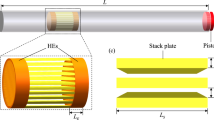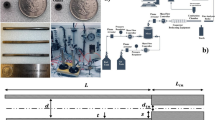Abstract
Effects of liquid fuel composition variations on characteristics of self-excited thermo-acoustic instabilities in a lean premixed, pre-vaporized gas turbine model combustor were experimentally studied. Test fuels included practical RP-3 jet fuel and its blending with iso-octane and n-dodecane, which were branched and linear alkanes respectively. Under the test conditions, dynamic pressure measurements indicated that the dominant instability frequency was highest for RP-3 flame, while RP-3/n-dodecane flame exhibited the strongest instability strength. A further analysis showed that the instability frequency correlated well with the profiles of adiabatic flame temperature, and the strength of the instability highly depended on the ignition delay times of the fuels. Measurements of the flame structure and flow field with OH* chemiluminescence (CL) imaging and two-dimensional particle image velocimetry (PIV) techniques indicated that changes in the fuel composition did not alter the unstable modes and general sequences of flame-flow structure oscillations. Further power spectra and proper orthogonal decomposition (POD) analysis suggested that axial oscillations along with precessing vortex core (PVC) induced helical motion predominated periodic flame structure and flow field oscillations.
Similar content being viewed by others
References
Rashwan S S, Nemitallah M A, Habib M A. Review on premixed combustion technology: Stability, emission control, applications, and numerical case study. Energy Fuels, 2016, 30: 9981–10014
Huang Y, Yang V. Dynamics and stability of lean-premixed swirl-stabilized combustion. Prog Energy Combust Sci, 2009, 35: 293–364
Chen L F, Liu D, Zhang H L, et al. Theoretical investigations on heat transfer to H2O/CO2 mixtures in supercritical region. Sci China Tech Sci, 2020, 63: 1018–1024
Poinsot T. Prediction and control of combustion instabilities in real engines. Proc Combust Institute, 2017, 36: 1–28
Sengissen A, Vankampen J, Huls R, et al. Les and experimental studies of cold and reacting flow in a swirled partially premixed burner with and without fuel modulation. Combust Flame, 2007, 150: 40–53
Sun P, Yuan Y, Ge B, et al. Combustion oscillation characteristics and flame structures in a lean premixed prevaporized combustor. Energy Fuels, 2017, 31: 10060–10067
Schadow K C, Gutmark E, Parr T P, et al. Large-scale coherent structures as drivers of combustion instability. Combust Sci Tech, 1989, 64: 167–186
Eckstein J, Freitag E, Hirsch C, et al. Experimental study on the role of entropy waves in low-frequency oscillations in a RQL combustor. J Eng Gas Turbines Power, 2004, 128: 264–270
Yu Y C, Sisco J C, Sankaran V, et al. Effects of mean flow, entropy waves, and boundary conditions on longitudinal combustion instability. Combust Sci Tech, 2010, 182: 739–776
Zhang K, Jiang X. Uncertainty quantification of fuel variability effects on high hydrogen content syngas combustion. Fuel, 2019, 257: 116111
Zhou H, Tao C. Effects of annular N2/O2 and CO2/O2 jets on combustion instabilities and nox emissions in lean-premixed methane flames. Fuel, 2020, 263: 116709
Taamallah S, Vogiatzaki K, Alzahrani F M, et al. Fuel flexibility, stability and emissions in premixed hydrogen-rich gas turbine combustion: Technology, fundamentals, and numerical simulations. Appl Energy, 2015, 154: 1020–1047
Hwang D, Song Y, Ahn K. Combustion instability characteristics in a dump combustor using different hydrocarbon fuels. Aeronaut J, 2019, 123: 586–599
Keller J O, Westbrook C K. Response of a pulse combustor to changes in fuel composition. Symposium (Int) Combust, 1988, 21: 547–555
Yilmaz İ, Ratner A, Ilbas M, et al. Experimental investigation of thermoacoustic coupling using blended hydrogen-methane fuels in a low swirl burner. Int J Hydrogen Energy, 2010, 35: 329–336
Yoon J, Joo S, Kim J, et al. Effects of convection time on the high harmonic combustion instability in a partially premixed combustor. Proc Combust Institute, 2017, 36: 3753–3761
Evans M J, Sidey J A M, Ye J, et al. Temperature and reaction zone imaging in turbulent swirling dual-fuel flames. Proc Combust Institute, 2019, 37: 2159–2166
Dooley S, Won S H, Heyne J, et al. The experimental evaluation of a methodology for surrogate fuel formulation to emulate gas phase combustion kinetic phenomena. Combust Flame, 2012, 159: 1444–1466
Ruan C, Chen F, Yu T, et al. Experimental study on combustion stability characteristics in liquid-fueled gas turbine model combustor: Fuel sensitivities and flame/flow dynamics. Fuel, 2020, 265: 116973
Galley D, Ducruix S, Lacas F, et al. Mixing and stabilization study of a partially premixed swirling flame using laser induced fluorescence. Combust Flame, 2011, 158: 155–171
McAllister S, Chen J Y, Fernandez-Pello A C. Fundamentals of Combustion Processes. Springer, 2011
Mao Y, Yu L, Wu Z, et al. Experimental and kinetic modeling study of ignition characteristics of RP-3 kerosene over low-to-high temperature ranges in a heated rapid compression machine and a heated shock tube. Combust Flame, 2019, 203: 157–169
Yu L, Wang W Y, Wang S X, et al. An experimental and modeling study of n-hexadecane autoignition under low-to-intermediate temperatures. Sci China Tech Sci, 2019, 63: 719–730
Ribaucour M, Minetti R, Sochet L R, et al. Ignition of isomers of pentane: An experimental and kinetic modeling study. Proc Combust Institute, 2000, 28: 1671–1678
Minetti R, Ribaucour M, Carlier M, et al. Autoignition delays of a series of linear and branched chain alkanes in the intermediate range of temperature. Combust Sci Tech, 2010, 113: 179–192
Yoon J, Kim M K, Hwang J, et al. Effect of fuel-air mixture velocity on combustion instability of a model gas turbine combustor. Appl Thermal Eng, 2013, 54: 92–101
Wicksall D, Agrawal A. Acoustics measurements in a lean premixed combustor operated on hydrogen/hydrocarbon fuel mixtures. Int J Hydrogen Energy, 2007, 32: 1103–1112
Kim D, Lee J G, Quay B D, et al. Effect of flame structure on the flame transfer function in a premixed gas turbine combustor. J Eng Gas Turbines Power-Trans ASME, 2010, 132: 021502
Lieuwen T, Mcdonell V, Petersen E L, et al. Fuel flexibility influences on premixed combustor blowout, flashback, autoignition, and stability. J Eng Gas Turbines Power-Trans ASME, 2008, 130: 15
Grohmann J, Rauch B, Kathrotia T, et al. Influence of single-component fuels on gas-turbine model combustor lean blowout. J Propulsion Power, 2018, 34: 97–107
Yu T, Li Z, Ruan C, et al. Development of an absorption-corrected method for 3D computed tomography of chemiluminescence. Meas Sci Technol, 2019, 30: 045403
Yu T, Ruan C, Chen F, et al. Measurement of the 3D rayleigh index field via time-resolved CH* computed tomography. Aerospace Sci Tech, 2019, 95: 105487
Panoutsos C, Hardalupas Y, Taylor A. Numerical evaluation of equivalence ratio measurement using OH* and CH* chemiluminescence in premixed and non-premixed methane-air flames. Combust Flame, 2009, 156: 273–291
Walsh K T, Long M B, Tanoff M A, et al. Experimental and computational study of CH, CH*, and OH* in an axisymmetric laminar diffusion flame. Symposium (Int) Combust, 1998, 27: 615–623
Hall J M, Petersen E L. An optimized kinetics model for oh chemiluminescence at high temperatures and atmospheric pressures. Int J Chem Kinet, 2006, 38: 714–724
Orawannukul P, Quay B, Santavicca D. An experimental validation of heat release rate fluctuation measurements in technically premixed flames. J Eng Gas Turbines Power, 2013, 135: 121505
Stöhr M, Boxx I, Carter C D, et al. Experimental study of vortex-flame interaction in a gas turbine model combustor. Combust Flame, 2012, 159: 2636–2649
Kypraiou A M, Allison P M, Giusti A, et al. Response of flames with different degrees of premixedness to acoustic oscillations. Combust Sci Tech, 2018, 190: 1426–1441
Steinberg A M, Boxx I, Stöhr M, et al. Flow-flame interactions causing acoustically coupled heat release fluctuations in a thermoacoustically unstable gas turbine model combustor. Combust Flame, 2010, 157: 2250–2266
Huang C, Gejji R, Anderson W, et al. Combustion dynamics in a single-element lean direct injection gas turbine combustor. Combust Sci Tech, 2020, 192: 2371–2398
Wang S, Yang V. Unsteady flow evolution in swirl injectors with radial entry. II. External excitations. Phys Fluids, 2005, 17: 045107
Sui J, Zhao D, Zhang B, et al. Experimental study of rijke-type thermoacoustic instability by using proper orthogonal decomposition method. Exp Thermal Fluid Sci, 2017, 81: 336–344
Liu Y, Li J, Han Q, et al. Study of combustion oscillation mechanism and flame image processing. AIAA J, 2019, 57: 824–835
Author information
Authors and Affiliations
Corresponding author
Additional information
This work was supported by the National Natural Science Foundation of China (Grant Nos. 91641202 and 501100001809), and the Program of Shanghai Subject Chief Scientist (Grant No. 19XD1401800).
Rights and permissions
About this article
Cite this article
Ruan, C., Chen, F., Yu, T. et al. Experimental study on impacts of fuel type on thermo-acoustic instability in a gas turbine model combustor. Sci. China Technol. Sci. 64, 1345–1358 (2021). https://doi.org/10.1007/s11431-020-1725-1
Received:
Accepted:
Published:
Issue Date:
DOI: https://doi.org/10.1007/s11431-020-1725-1




